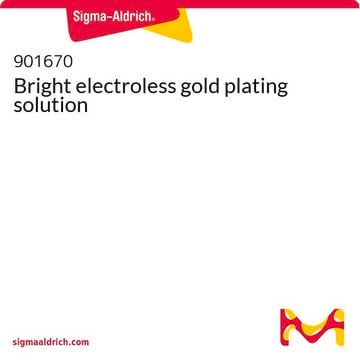901655
Electroless nickel plating solution
ammonia free
Synonim(y):
Nickelex
About This Item
Polecane produkty
Postać
liquid
kolor
blue to green
pH
4.8-5.2
Szukasz podobnych produktów? Odwiedź Przewodnik dotyczący porównywania produktów
Powiązane kategorie
Opis ogólny
Advantages
- Stable, ready to use
- Plates without generating ammonia fumes
- Produces quality electrical contacts on p- and n-type silicon
- Does not compensate for p- or n- type conductivity
- Excellent adhesion and solderability
- Plates on silicon, germanium, gallium arsenide, cadmium sulfide
The chemical reaction during the electroless plating process involves an oxidation-reduction reaction between nickelous and hypophosphite ions. The reaction is essentially a two step process occurring simultaneously.
(1) H2PO2- + H2O --> H2OPO3- + H2
(2) Ni ++ (complex) + H2 --> Ni + 2H+
The reaction progresses catalytically with nickel deposition occurring at the operating temperature of 95 °C - 100 °C. The nascent hydrogen evolved insures an oxide free nickel deposit. In addition some NiP formed in a side reaction improves corrosion resistance and solderability. The nickel deposit is highly conductive, remains unstressed, particularly after suitable heat treatment, and shows good adherence.
Zastosowanie
- Nickelex provides good mechanical and electrical contacts for semicodonductor devices (silicon rectifers, solar cells, varactors, microwave diodes, transistors, microcircuits, etc.). The quality of the electrical contact is excellent if the surface of silicon is abraded by lapping to increase surface recombination velocity; if the surface is highly doped from diffusion; or if the semicondcutor resistivity is low (0.1 ohm-cm). Nickelex also produces adherent deposits on germanium, gallium arsenide, and cadmium sulfide.
- The Nickelex plate exhibits excellent solderability with lead, tin, and Pb/Sn alloys. Flux can be omitted when furnaced soldered in a hydrogen or non-oxidizing atmosphere.
Instructions
Complete metallization procedures are provided for silicon rectifier and planar device fabrication. These procedures should be followed to obtain optimum adhesion of nickel and quality of the ohmic contacts.
Hasło ostrzegawcze
Danger
Zwroty wskazujące rodzaj zagrożenia
Zwroty wskazujące środki ostrożności
Klasyfikacja zagrożeń
Acute Tox. 3 Dermal - Acute Tox. 3 Oral - Acute Tox. 4 Inhalation - Aquatic Acute 1 - Aquatic Chronic 1 - Carc. 1A Inhalation - Eye Irrit. 2 - Muta. 2 - Repr. 1B - Resp. Sens. 1 - Skin Irrit. 2 - Skin Sens. 1 - STOT RE 1
Organy docelowe
Lungs
Kod klasy składowania
6.1C - Combustible acute toxic Cat.3 / toxic compounds or compounds which causing chronic effects
Klasa zagrożenia wodnego (WGK)
WGK 3
Temperatura zapłonu (°F)
Not applicable
Temperatura zapłonu (°C)
Not applicable
Certyfikaty analizy (CoA)
Poszukaj Certyfikaty analizy (CoA), wpisując numer partii/serii produktów. Numery serii i partii można znaleźć na etykiecie produktu po słowach „seria” lub „partia”.
Masz już ten produkt?
Dokumenty związane z niedawno zakupionymi produktami zostały zamieszczone w Bibliotece dokumentów.
Klienci oglądali również te produkty
Nasz zespół naukowców ma doświadczenie we wszystkich obszarach badań, w tym w naukach przyrodniczych, materiałoznawstwie, syntezie chemicznej, chromatografii, analityce i wielu innych dziedzinach.
Skontaktuj się z zespołem ds. pomocy technicznej












